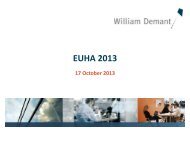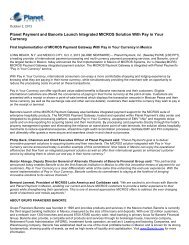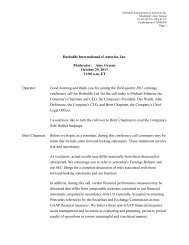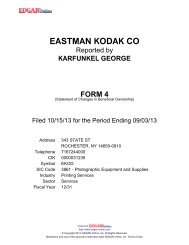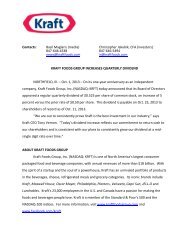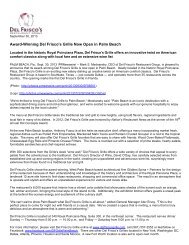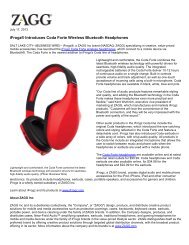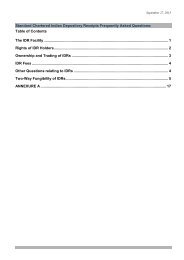Hypercom Corporation Annual Report - CiteSeer
Hypercom Corporation Annual Report - CiteSeer
Hypercom Corporation Annual Report - CiteSeer
You also want an ePaper? Increase the reach of your titles
YUMPU automatically turns print PDFs into web optimized ePapers that Google loves.
Revenue Recognition<br />
Revenue is recognized when the following criteria are met: (a) persuasive evidence that an arrangement exists; (b) delivery of<br />
the products or services has occurred; (c) the selling price is both fixed and determinable; and (d) collectability is reasonably assured.<br />
The Company generally recognizes products revenues, including sales to distributors and sales under sales-type leases, upon<br />
shipment of product. The Company recognizes services revenues when the services have been provided and collection is reasonably<br />
assured. Routine recurring services include terminal repairs, help-desk, on-site technician visits, deployment and the provision of<br />
supplies. Amounts received in advance of services being rendered are recorded as deferred revenue. Revenues from long-term<br />
contracts that require substantial performance of customized software and hardware over an extended period are recorded based upon<br />
the attainment of substantive scheduled performance milestones under the percentage-of-completion method. Operating lease revenue<br />
is recognized monthly over the lease term. The units leased under operating leases are included in the balance sheet under “Property,<br />
plant and equipment.” The Company accrues for warranty costs, sales returns and other allowances at the time of shipment.<br />
Revenue arrangements with multiple deliverables are evaluated to determine if the deliverables (items) can be divided into<br />
more than one unit of accounting. An item can generally be considered a separate unit of accounting if all of the following criteria are<br />
met:<br />
• The delivered item(s) has value to the customer on a standalone basis;<br />
• There is objective and reliable evidence of the fair value of the undelivered item(s); and<br />
• If the arrangement includes a general right of return relative to the delivered item(s), delivery or performance of the<br />
undelivered item(s) is considered probable and substantially in the control of the Company.<br />
Items that do not meet these criteria are combined into a single unit of accounting. If there is objective and reliable evidence of<br />
fair value for all units of accounting, the arrangement consideration is allocated to the separate units of accounting based on their<br />
relative fair values. In cases where there is objective and reliable evidence of the fair value(s) of the undelivered item(s) in an<br />
arrangement but no such evidence for one or more of the delivered item(s), the residual method is used to allocate the arrangement<br />
consideration. In cases in which there is not objective and reliable evidence of the fair value(s) of the undelivered item(s) but a portion<br />
of the arrangement is considered to be a lease, the Company recognizes where it has sufficient evidence to make an estimate of the<br />
relative fair values of the delivered elements.<br />
The Company presents revenues net of sales taxes and value-added taxes in its consolidated statements of operations.<br />
Shipping and Handling Costs<br />
Shipping costs include charges associated with delivery of goods from the Company’s facilities to its customers and are<br />
reflected in cost of product. Shipping costs paid to the Company by its customers are classified as revenue.<br />
Product Warranty<br />
The Company accrues for estimated warranty obligations when revenue is recognized based on an estimate of future warranty<br />
costs for delivered products and specific known product issues. Such estimates are based on historical experience and expectations of<br />
future costs. The Company periodically evaluates and adjusts the accrued warranty costs to the extent actual warranty costs vary from<br />
the original estimates. The Company’s warranty period typically extends from one to five years from the date of shipment. Costs<br />
associated with maintenance contracts, including extended warranty contracts, are expensed when they are incurred. Actual warranty<br />
costs may differ from management’s estimates.<br />
Legal and Other Contingencies<br />
In the ordinary course of business, the Company is involved in legal proceedings involving contractual and employment<br />
relationships, product liability claims, intellectual property rights, and a variety of other matters. The Company records contingent<br />
liabilities resulting from asserted and unasserted claims against it, when it is probable that a liability has been incurred and the amount<br />
of the loss is estimable. Estimating probable losses requires analysis of multiple factors, in some cases including judgments about the<br />
potential actions of third-party claimants and courts. Therefore, actual losses in any future period are inherently uncertain. Currently,<br />
the Company does not believe any of its pending legal proceedings or claims will have a material impact on its financial position,<br />
- 57 -



